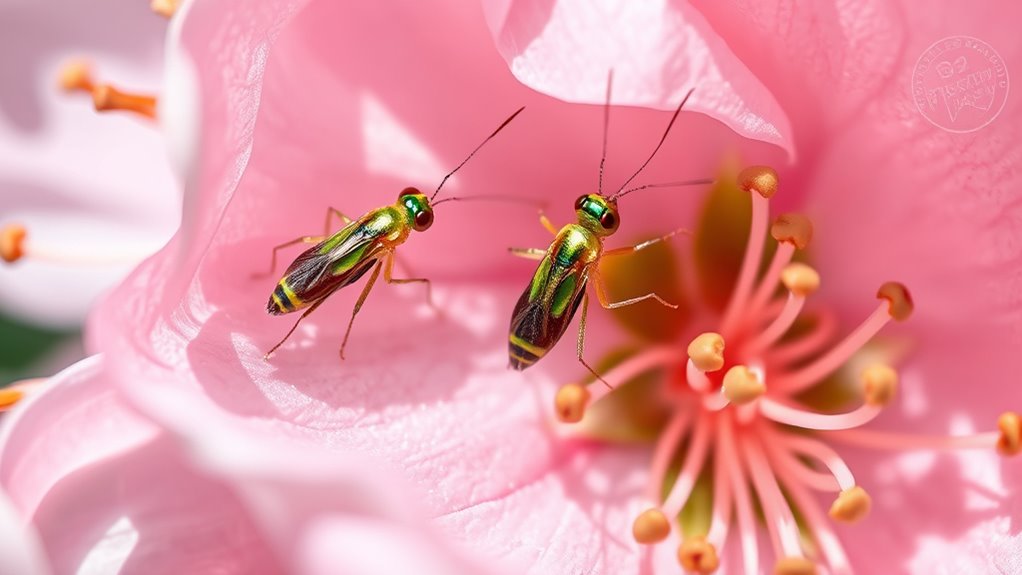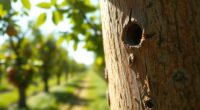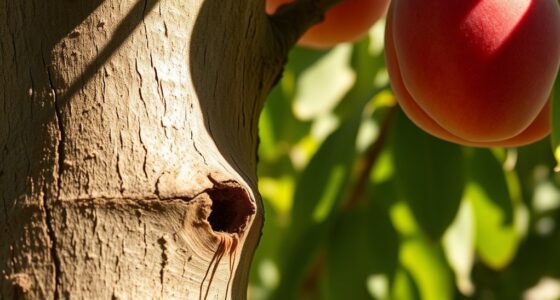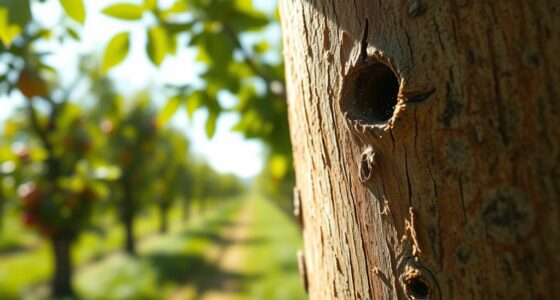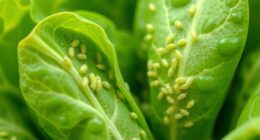If you spot thrips on your stone fruit blossoms, early detection is key to preventing damage. Regularly inspect flowers and surrounding foliage, and use sticky traps or tap blossoms over white sheets to catch these tiny insects. Keep detailed records of thrips levels to time your management actions effectively. Combine cultural controls, targeted insecticides, and biological methods for best results. If you want to learn how to identify and control thrips efficiently, keep exploring the best strategies.
Key Takeaways
- Detect thrips early during bloom by inspecting flowers and using sticky traps to prevent crop damage.
- Look for tiny, fringed-wing insects at blossom bases and on new growth.
- Keep detailed records of thrips populations to identify trends and determine intervention timing.
- Combine cultural practices, targeted insecticides, and biological controls for effective Integrated Pest Management.
- Regular monitoring and precise treatment help reduce damage, distortions, and scarring on stone fruit crops.
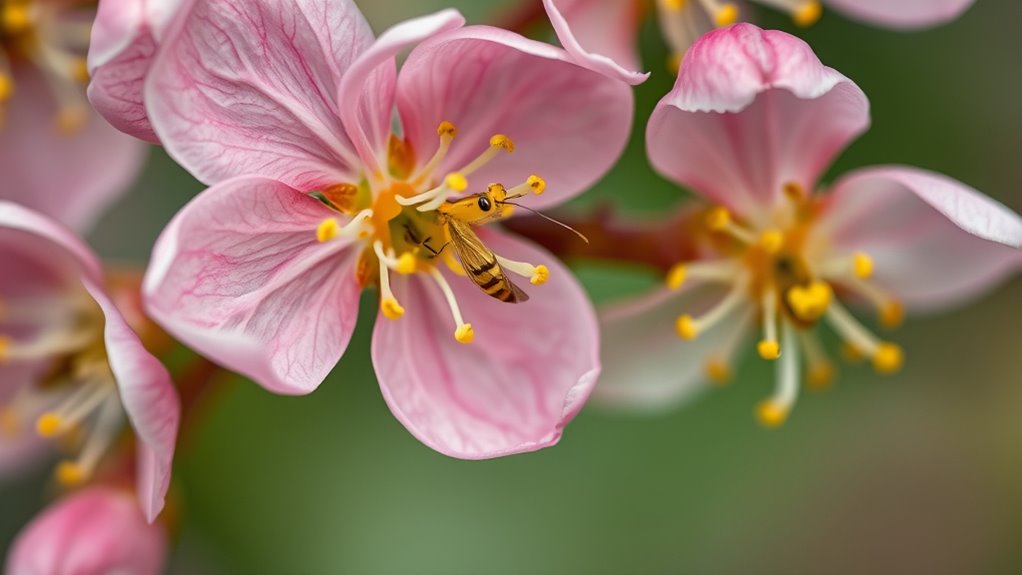
As stone fruit blossoms begin to open, thrips become active pests that can substantially damage your fruit crops. These tiny insects feed on the flower petals, stamen, and developing fruit, leading to distorted growth, scarring, and reduced yields. Early detection is key to managing thrips effectively, so you need to implement proper pest management strategies right from the start of bloom. Monitoring techniques play a crucial role in identifying thrips presence before populations reach damaging levels, allowing you to act swiftly and prevent significant crop losses.
Early detection of thrips during bloom is vital to prevent crop damage and ensure healthy fruit development.
To effectively monitor thrips, you should regularly inspect your blossoms and surrounding foliage. Use sticky traps placed within the orchard to catch flying adults, which provides an ongoing indication of population levels. Additionally, tapping a flower over a white sheet or a piece of paper can help dislodge thrips, making them easier to count. Look for tiny, slender insects with fringed wings that are often difficult to see without close inspection. Pay particular attention to the base of the blossoms and new growth, as thrips tend to congregate there. Keep detailed records of your observations, noting the number of thrips found per blossom or trap, and track changes over time.
Implementing integrated pest management (IPM) begins with these monitoring efforts. When you detect thrips at low to moderate levels, cultural controls like removing heavily infested plant debris and pruning to improve airflow can reduce their habitat. You may also consider applying targeted insecticidal treatments when monitoring indicates a rising population. Use insecticides specifically labeled for thrips on stone fruit, and follow the recommended application timing—usually during bloom or early fruit development—to maximize effectiveness while minimizing impact on beneficial insects. Always adhere to label instructions to avoid resistance buildup and environmental harm.
You should also consider biological controls, such as introducing natural predators like predatory thrips or minute pirate bugs, which can help keep thrips populations in check. Combining these biological agents with vigilant monitoring and cultural practices creates a sustainable pest management approach. Remember, timing and consistency are vital; frequent monitoring ensures you catch thrips before they cause irreversible damage, and targeted interventions prevent unnecessary pesticide use.
Frequently Asked Questions
How Can I Differentiate Thrips From Other Blossom Pests?
You can differentiate thrips from other blossom pests through visual identification; thrips are tiny, slender insects with fringed wings, often less than 1/16 inch long. Look for damage symptoms like silvery or speckled spots on blossoms and distorted flowers. Unlike larger pests, thrips are difficult to see without a magnifier, but their distinctive shape and damage signs help you identify them quickly and distinguish them from other pests on stone fruit blossoms.
Are There Natural Predators for Thrips on Stone Fruit?
Yes, natural predators like predatory mites and minute pirate bugs target thrips on stone fruit. While they may seem fragile, these beneficial insects play a vital role in biological control, reducing thrips populations naturally. You can encourage their presence by avoiding broad-spectrum insecticides and planting diverse habitats. This balance helps keep thrips in check, promoting healthier blossoms without relying solely on chemical interventions.
What Is the Economic Impact of Thrips Infestations?
Thrips infestations can cause significant economic losses by damaging blossoms and fruit, leading to reduced yields and fruit quality. These infestations also impact marketability, as damaged fruit may not meet quality standards, resulting in lower prices or rejection. The economic impact extends beyond individual orchards, affecting regional and national markets. Managing thrips effectively is vital to minimizing these losses and maintaining a healthy, profitable stone fruit industry.
When Is the Best Time to Apply Control Measures?
You should time your sprays precisely during the bloom stage to outsmart those pesky thrips. The timing of sprays is essential—wait too long, and they’ll have already done their damage; spray too early, and you waste your effort. Focus on bloom stage control to keep thrips at bay, ensuring your fruit blossoms stay healthy and your harvest isn’t sabotaged by these tiny invaders.
Can Thrips Cause Fruit Deformities or Just Blossom Damage?
Thrips can cause both fruit deformities and blossom damage. When they feed on blossoms, you might see distorted or scarred flowers, which can reduce fruit set. If they feed on developing fruit, deformities like scarring or misshapen fruit can occur. It’s important to monitor thrips populations early, as damage to blossoms and fruit can markedly impact your harvest. Effective control helps prevent both blossom damage and future fruit deformities.
Conclusion
So, next time you see those tiny thrips flitting around your stone fruit blossoms, remember—they’re not just adorable nuisances. Ignoring them might turn your beautiful orchard into a thrips paradise, complete with ruined blooms and empty branches. But hey, who needs perfect fruit anyway? Just sit back, enjoy the chaos, and let nature take its course—after all, what’s a little destruction in the grand scheme of things?
